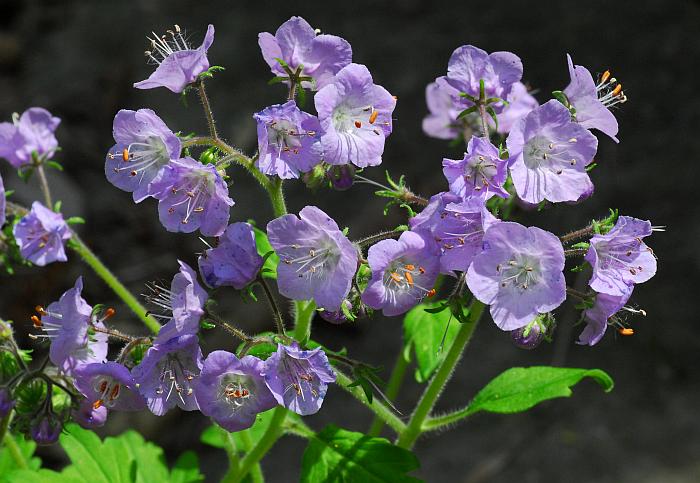Phacelia bipinnatifida Michx.
Forest Phacelia

Native
CC = 5
CW = 5
MOC = 9
© SRTurner
Phacelia bipinnatifida Michx.Forest Phacelia | |
 |
Native CC = 5 CW = 5 MOC = 9 |
© SRTurner |
|
Family - Hydrophyllaceae Habit - Robust biennial forb. Stems - Ascending to erect from an often spreading base, to 60 cm, usually several-branched at the base and above, moderately to densely pubescent with stiff, spreading to somewhat downward-angled, nonglandular hairs toward the base, these grading into dense, shorter, gland-tipped hairs above the midpoint.
Leaves - Basal and alternate. Basal leaves often persistent at flowering, the blade 7-12 cm long, broadly ovate to ovate-triangular in outline, pinnately compound with 3-7 pinnae, these mostly deeply 2-or 3-lobed and also coarsely several-toothed to moderately lobed, the teeth or lobes sharply pointed at the tips, the surfaces sparsely to moderately pubescent with loosely appressed to somewhat spreading, stiff hairs, the undersurface sometimes nearly glabrous and usually pale green. Stem leaves all moderately to long-petiolate, the petioles to 10 cm, the blades 1.5-9.0 cm long, progressively less divided toward the stem tip, the uppermost leaf blades often irregularly 3-or 5-lobed, the terminal lobe somewhat tapered at the base, the pubescence similar to that of the basal leaves.
Inflorescence - Terminal panicles with 5-25 flowers, the axis and flower stalks elongating in fruit, densely pubescent with gland-tipped hairs, the stalks downward-arched or pendant at fruiting.
Flowers - Calyces 4-8 mm long, the lobes spreading, linear, 5-6 mm long, 1 mm broad, with the margins and surfaces pubescent with a mixture of nonglandular and gland-tipped hairs. Corollas 7-10 mm long, broadly bell-shaped, 5-lobed, 7 mm long and broad, pale lavender to strongly bluish-tinged, the margins minutely irregular or scalloped, the outer surface finely hairy. Stamens 5, slightly exserted, alternating with the corolla lobes, the filaments usually 8-12 mm long, densely hairy for most of their length. Ovary superior, unilocular, with 4 ovules. Style shallowly to deeply branched.
Fruits - Capsules 4-6 mm long, subglobose, densely hairy, the surface not appearing swollen, 4-seeded. Seeds 3-4 mm long, ovoid-angled, finely ridged and/or pitted, black.
Flowering - April - June. Habitat - Streambanks, bottomland forests, ravines, and bases and ledges of bluffs. Origin - Native to U.S. Lookalikes - Hydrophyllum appendiculatum. Other info. - This beautiful plant is relatively uncommon in Missouri, which lies at the westward extent of its range. Elsewhere, it occurs in a patch within several Midwestern states but does not extend to coastal areas. Interestingly, it is common along the eastern edge the Mississippi River floodplain in Illinois but virtually absent from the western edge in Missouri. The plant is easily recognized by its characteristic leaves, which are often mottled with lighter blotches, and its panicles of lavender-colored flowers. It is a much larger plant than other Missouri species of Phacelia and can be very showy when in full bloom. Photographs taken outside of Van Buren, MO., 4-16-01, and at Reform Conservation Area, Callaway County, MO., 3-11-04 (DETenaglia); also at Salt Lick Point, near Valmeyer, Monroe County, IL, 4-16-2012, 4-30-2018, and 5-1-2018, and along the Katy Trail near Klondike Park, St. Charles County, MO, 4-30-2015 (SRTurner). |